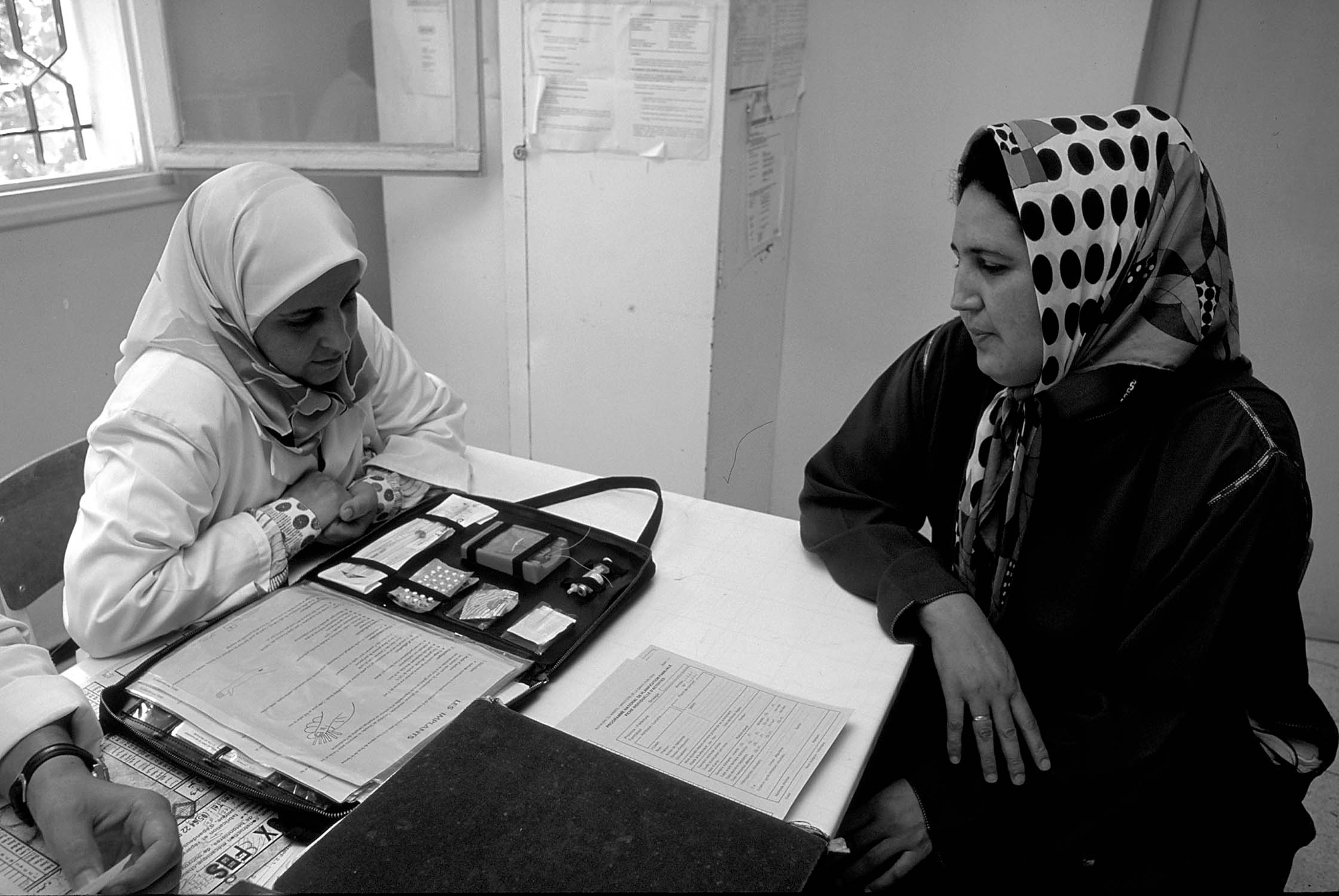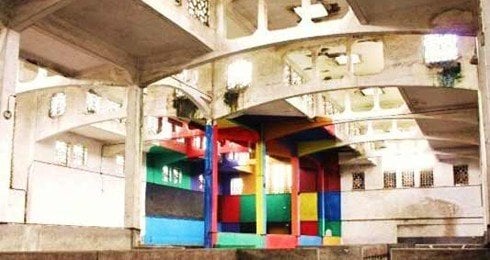Malik, two months old, opens his eyes and the first image he has of the world is that of a community of desperate women where his mother sought refuge a few weeks after his birth. All the women here are victims of violence and have left their homes carrying nothing but their children. They walked straight in front of them asking for a taxi to take them to the association.
Tilila means freedom in Amazigh. The structure was established in May 2006 by the Democratic League for Women’s Rights (LDDF) to give shelter to helpless women, who sometimes are even threatened to death. This shelter is meant as an alternative to the shortfalls observed in other fields of activity of the LDDF, especially in the INJAD network of legal assistance and that of the Centre of Information and Observation of Moroccan Women (CIOFEM). These centres propose a questionnaire and the results serve as the basis to the legal claims of the LDDF.
The shelter, whose address is kept secret for obvious security reasons can host up to 20 women and has a staff of 7 employees. It is one of the rare ones to accept women with their children.
The women are sent there by the INJAD network or by other associations, “They carry out a first selection, to see what can be done and avoid giving fake hopes, explains Jamila, the head of Tilila. We don’t accept single women, drug addicts or prostitutes”. They’re aged between 20 and 24 and are running from difficult situations from all the regions of Morocco.
Some of them have worked as housemaids or factory workers and most are mainly illiterate. Most of them were married young, sometimes before they turned 16. All these women have suffered all kinds of violence and humiliations: blows and injuries, sexual, psychological or economical violence (their salaries were robbed or they did not receive contributions for house expenses for instance). In most cases the aggressor is the husband, more rarely the fathers or brothers. Some of them have already been hospitalised several times, even in psychiatry due to depression. They endured violence for many years, and only when they felt that their life was at stake they decided to leave. Though quite often, the first time they leave their homes, it is not for good. Many have left several times and have gone back as they couldn’t find another solution. “If they don’t manage to take all their children with them, they worry and usually go back” explains Kenza, the psychologist. Furthermore, they never stop hoping that things can change.
Caught up in the mechanism
When they arrive to Tilila, they’re shattered. They need to think without being pressed and understand what to do with their lives. Most of all, they need to rebuild themselves and regain some self-confidence. Psychological support is therefore the most important aspect of this institution. Kenza sees them individually twice a week: “At the beginning they’re thrilled by the fact that they’ve broken free. They empty themselves. Then come anguish and feelings of guilt”. The golden rule is not to influence them. “I never push them to divorce or do the opposite. I just remind them that violence is neither legal nor normal, that they don’t need to accept it and that divorce is a possibility”. Kenza also encourages the women to speak to each other, in that way “they put their situation in plain words and try to understand why they stayed for so long”.
Their stay in Tilila lasts about two months, but they can come back. Usually they make a decision after coming back several times. Legal follow ups are proposed to those who seek divorce, or want to lay charges for blows and injuries.
During their stay, they need to follow a strict discipline: “The security of the whole group is at stake” explains Jamila. And living in a community? “You get used to it”, reveals Khadija. You don’t have the choice and it’s one of the difficulties that the group has to face. According to Kenza: “They suffer group life, they need some time alone, while the group reflects an image they don’t want to recognise. Moreover they repeat the violence they lived in by communicating it implicitly, almost imperceptibly, in search for scapegoats”. They are also violent against their children who are also shocked. “Children are happy to leave this environment where they also have suffered violence (burns, fractures…) but they feel guilty they escaped”, explains Kenza, who also follows them when they have obvious difficulties in integrating with the group or have self-destructive attitudes. In the mornings and afternoons, the women follow courses for small manual works (sewing, embroidery, knitting, crochet…), painting or cooking. Reading and writing lessons and courses in health, education and law are also proposed. But explains Kenza: “They’re troubled, worried by more immediate issues and don’t have much chance to concentrate”. Meals are a good occasion to strengthen the ties with children because “some mothers just want to resign and they need support”, explains Aicha, the paediatrician. On mornings and evenings she teaches the smaller children to colour and paint and the older ones to read and write (5 to 6), as some have been taken out of school during the year.
Once out of Talila, problems are yet to be solved. When grouped, the women are more aggressive and willing, in order to encourage themselves. But, individually, they recall their pains and worry about the future. Indeed, it is difficult to find a job, a home and a solution to send the children to school and to baby-sit them when you’re forced to change town, you have no education, sometimes even no identity papers and your self-confidence is in shatters: it’s an open door to falling back into violence or prostitution. The centre is now trying to create a support to find work as, explains Jamila, “only financial independence can allow them to consolidate their renewed self-confidence and this freedom”.
A society that produces violence
This freedom is even more difficult to obtain because society itself produces violence. If the lodgers of Tilila manage, after all their suffering, to break the vicious cycle of physical violence, they remain subject to cultural and structural violence.
Yet, some action has been taken in this regard since the first national campaign against violence towards women was carried out in November 1998: TV ads; posters; awareness programmes on the types of violence and their consequences; statistical studies to give an institutional visibility to the issue; the establishment, in 2002, of specific cells for victims of marital violence; and a survey record in the hospitals Ibn Sina in Rabat and Ibn Rochd in Casablanca; the creation of a special institution against family violence hosted by the Directorate General for National Security (DGSN)… The issue is tackled more and more overtly. Many of Tilila’s women recall the awareness campaign: “all of them had memorised the free phone”, underlines Kenza.
Despite this fact, reminds Jamila: “ our society trivialises violence and beating wives is normal in common belief. Mothers, mothers in law and sisters in law play a role in reproducing the model”. Even more so when poor couples live in the family home of the husband: “Quite often families connive or participate to the violence” insists Kenza. The idea that family, marital or sexual violence is part of the private sphere is still very common, as well as the fact that, as in a patriarchal society such as this, women are responsible for the good running of the home. “In one year, apart from three cases, all the families tried to force the woman to go back to her husband”, states Jamila. Families and neighbours, never intervene out of fear, or lately they have started saying that “women should start making it on their own”..
From a structural point of view, the economical situation is lived as violence and can only lead to it: “All violent husbands are drug addicts or alcoholics, either unemployed or professionally unstable” underlines Kenza. It’s a direct link, supported by all the studies on the matter, although following to a survey carried out by the Democratic Association for Women in Morocco (AMDF) in 2000, the idea that violence is exceptional and accidental still lives. Moreover, reminds Jamila: “the fact that we speak about it has a negative effect on the young men of poorer neighbourhoods: they feel that people only speak of women’s problems and not theirs”, thus strengthening a “crisis in men” that can only increase violence. Furthermore, the access to satellite chains and pornography has had an important impact on sexual violence.
An inappropriate legal system
Women feel that some laws produce violence against them. The adoption of the new Mudawana in 2004 has not been followed by a harmonisation of the legal system, from which ensue contradictions and deficiencies. Feminist associations keep fighting against this. Article 475 of the Penal Code allows the abductor of a single of minor age to avoid pursuits if he marries her. According to Kenza, this is a catastrophe: “in marriages made to cover rapes, the raper has his revenge”. The Penal code doesn’t take into consideration the notion of marital rape, as the body of the married woman is supposed to belong to the husband. Keeping polygamy, even under certain conditions, is also a source of violence. Habiba was beaten by her husband because she refused that he takes a second wife. No obligation is imposed on violent husbands.
The existence of shelters like Tilila or those founded by other associations like the Union for Female Action, is precarious. “no law protects the shelter. The Penal Code still punishes those who hide a woman who flees her husband’s home”, reminds Jamila. Article 496 contemplates two to five years of jail, assorted with a fine, to all those who give hospitality to “a married woman who flees the authority to which she is legally submitted” (notion of submission to the authority which has been suppressed by the Mudawana) without taking into account the reason that pushed the woman to leave her home. With these conditions, opening a shelter is therefore not an easy task: “The concept of shelter entails anonymity, but with time it becomes known. The comings and goings of women titillate people’s curiosity who ask themselves what’s happening inside. The relationships with the neighbourhood have a jagged edge” explains Jamila. Therefore Tilila can only live thanks to the support of the authorities, but with a shaky equilibrium.
At present, only ONGs have mobilised themselves. Tilila is launching a bid for funds to purchase an apartment and obtain a more stable position. However, considering the difficulty of the situation, the State should assume its responsibilities.
Contacts and information
To send donations:
LDDF/CH 011 780 0000 51 210 08 60009/42 Agence Mers Sultan, BMCE Casa maroc
VIOLENCE IN NUMBERS
The nature of violence
Data derived from the Study carried out by CIOFEM between 2000 and 2003, on 3795 forms for raped women:
Legal nature of the offence | Nature of the offence | Total |
Offence (21,34%) | Blows and injuries, insults, death threats | 19,13% |
Adultery | 2,21% | |
Crime | Rape | 4,11% |
Personal status (67,52%) | Maintenance after divorce | 26, 80% |
Return Home and expulsion of guardian (hadina) | 7,04% | |
Polygamy | 0,87% | |
Abandonment and lack of maintenance | 8,06% | |
Divorce | 14,07% | |
Recognition of fatherhood | 7,83% | |
Deprivation of heritage | 2,85% |
The authors of violence
Data derived from the survey carried out on 1218 women who benefited from the activities of the LDDF centre in 2007
Relationship with the victim: 96,41% of aggressions were committed by husbands (80,06%), boyfriends or ex husbands (11,42%)
Age: more than 50% are between 30 and 49 years old
School level: more than 50% are illiterate, and 5,6% university graduates
The victims of violence
Data derived from the survey carried out on 1218 women who benefited from the activities of the LDDF centre in 2007
Age: 88,8% are between 18 and 49 years old (34,43% between 28 and 38).
Economical situation: 57,38% are housewives; 13,2% are unemployed; 9,61% work off contract; 90,83% is in a vulnerable situation.
Marital status: 60% married.
Number of children: 53,08% have 2 children; 26,11% have more than 3 children; 20,37% have no children.
School level: 37,16% are illiterate and have never attended school; 31,7% have a primary level (therefore 68,68% is almost illiterate); 3, 73 are university graduates.
Habitat: 26,8% live in shantytowns.
General data on the Moroccan situation:
Data derived from the PNUD report 2007-2008
Urban Population: 58,7% in 2005
People aged less than 30: 30,3% in 2005
Fertility rate: 2,5% between 2000 and 2005
Unemployment rate: 11% between 1995 and 2005. in 1995, 47% of women work off the record, equal to 45% of the economy
Illiteracy rate: 34,3% between 1995 and 2005 men and women; 60,4% of women, considering that the percentage can reach 90% in rural areas.
Names have been changed.





